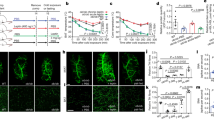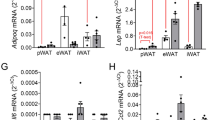Abstract
BACKGROUND: In fa/fa Zucker rats, leptin receptor deficiency is responsible for both a deficit of energy expenditure and hyperphagia which lead to massive obesity and insulin resistance in adulthood. This obesity is also characterised by alterations of the β-adrenergic signaling pathway.
OBJECTIVE: To determine whether alterations in β-adrenergic pathway could occur at the onset of obesity when fa/fa rats are not yet hyperinsulinemic.
ANIMALS: Fourteen-day-old suckling fa/fa and Fa/fa littermates (from heterozygous lean (Fa/fa) female and homozygous obese (fa/fa) male mating).
MEASUREMENTS: Membranes were prepared from isolated adipocytes after collagenase treatment of inguinal adipose tissue. The response of adenylyl-cyclase activity to stimulation by isoprenaline, GTPγ-S or forskolin was studied. Bmax and Kd of (β1+β2) and of β3 adrenoceptors were measured using 3H-CGP saturation binding experiments. mRNA concentration of β1- and β3-AR was determined by semi-quantitative RT-PCR. Gsα protein was quantified by Western blotting and Gi protein by ADP-ribosylation.
RESULTS: Despite an almost normal body weight, inguinal fat pad weight was increased two-fold by the expression of fa mutation. This increase was entirely accounted for by fat cell hypertrophy (×2.5 in volume). In fa/fa compared to Fa/fa pups, response of adenylyl cyclase to isoprenaline was decreased two-fold but responses to GTPγS or forskolin were unchanged. Density of (β1+β2) and β3-AR was not affected by the fa/fa genotype, as well as Gsα and Gi concentration.
CONCLUSION: Response of inguinal fat cells to catecholamines was decreased without any quantitative modifications of the different elements of the adenylyl cyclase cascade. This suggests an alteration in the coupling between β-AR and G proteins. Due to the important increase in fat cell volume we hypothesize that changes in the physical properties of plasma membranes and/or changes in cytoskeleton–extracellular-matrix interactions could disturb the β-adrenergic pathway responsiveness. In addition to the excess of lipid storage, which occurs very early at the onset of obesity, the impairment of the responsiveness to catecholamines reported in this study might worsen the obesity syndrome.
This is a preview of subscription content, access via your institution
Access options
Subscribe to this journal
Receive 12 print issues and online access
$259.00 per year
only $21.58 per issue
Buy this article
- Purchase on Springer Link
- Instant access to full article PDF
Prices may be subject to local taxes which are calculated during checkout




Similar content being viewed by others
References
Phillips MS, Liu Q, Hammond HA, Dugan V, Hey PJ, Caskey CJ, Hess JF . Leptin receptor missense mutation in the fatty Zucker rat Nature Genet 1996 13: 18–19.
Campfield LA, Smith FJ, Guisez Y, Devos R, Bum P . Recombinant mouse OB protein: evidence for a peripheral signal linking adiposity and central neural networks. [See comments.] Science 1995 269: 546–549.
Krief S, Bazin R . Genetic obesity: is the defect in the sympathetic nervous system? A review through developmental studies in the preobese Zucker rat Proc Soc Exp Biol Med 1991 198: 528–538.
Boulangé A, Planche E, de Gasquet P . Onset of genetic obesity in the absence of hyperphagia during the first week of life in the Zucker rat (fa/fa) J Lipid Res 1979 20: 857–864.
Bazin R, Eleve D, Lavau M . Evidence for decreased GDP binding to brown-adipose-tissue mitochondria of obese Zucker (fa/fa) rats in the very first days of life Biochem J 1984 221: 241–245.
Deng C, Moinat M, Curtis L, Nadakal A, Preitner F, Boss O, Assimacopoulos JF, Seydoux J, Giacobino JP . Effects of beta-adrenoceptor subtype stimulation on obese gene messenger ribonucleic acid and on leptin secretion in mouse brown adipocytes differentiated in culture Endocrinology 1997 138: 548–552.
Charon C, Krief S, Diot-Dupuy F, Strosberg AD, Emorine LJ, Bazin R . Early alterations in the brown adipose tissue adenylate cyclase system of pre-obese Zucker rat fa/fa pups: decreased G-proteins and beta 3-adrenoceptor activities Biochem J 1995 312: 781–788.
Bazin R, Lavau M . Development of hepatic and adipose tissue lipogenic enzymes and insulinemia during suckling and weaning on to a high-fat diet in Zucker rats J Lipid Res 1982 23: 839–849.
Gruen R, Hietanen E, Greenwood MR . Increased adipose tissue lipoprotein lipase activity during the development of the genetically obese rat (fa/fa) Metabolism 1978 27: 1955–1966.
Germack R, Starzec AB, Vassy R, Perret GY . Beta-adrenoceptor subtype expression and function in rat white adipocytes Br J Pharmac 1997 120: 201–210.
Soeder KJ, Snedden SK, Cao W, Della RG, Daniel KW, Luttrell LM, Collins S . The beta3-adrenergic receptor activates mitogen-activated protein kinase in adipocytes through a Gi-dependent mechanism J Biol Chem 1999 274: 12017–12022.
Lavau M, Bazin R . Inguinal fat pad weight plotted versus body weight as a method of genotype identification in 16-day-old Zucker rats J Lipid Res 1982 23: 941–943.
Rodbell M . Metabolism of isolated fat cells. 1. Effects of hormones on glucose metabolism and lipolysis J Biol Chem 1964 239: 375–380.
Rafael J, Vsiansky P . Quantitative determination of nucleic acids in brown and white adipose tissue Anal Biochem 1981 115: 158–162.
Bradford MM . A rapid and sensitive method for the quantitation of microgram quantities of protein utilizing the principle of protein-dye binding Anal Biochem 1976 72: 248–254.
Adli H, Bazin R, Perret GY . Interaction of amiodarone and trilodothyronine on the expression of beta-adrenoceptors in brown adipose tissue of rat Br J Pharmac 1999 126: 1455–1461.
Kent RS, De Lean A, Lefkowitz RJ . A quantitative analysis of beta-adrenergic receptor interactions: resolution of high and low affinity states of the receptor by computer modeling of ligand binding data Mol Pharmac 1980 17: 14–23.
Nahmias C, Blin N, Elalouf JM, Mattei MG, Strosberg AD, Emorine LJ . Molecular characterization of the mouse beta 3-adrenergic receptor: relationship with the atypical receptor of adipocytes EMBO J 1991 10: 3721–3727.
Feve B, Baude B, Krief S, Strosberg AD, Pairault J, Emorine LJ . Inhibition by dexamethasone of beta 3-adrenergic receptor responsiveness in 3T3-F442A adipocytes. Evidence for a transcriptional mechanism J Biol Chem 1992 267: 15909–15915.
Commins SP, Watson PM, Levin N, Beiler RJ, Gettys TW . Central leptin regulates the UCP1 and ob genes in brown and white adipose tissue via different beta-adrenoceptor subtypes J Biol Chem 2000 275: 33059–33067.
Niijima A . Reflex effects from leptin sensors in the white adipose tissue of the epididymis to the efferent activity of the sympathetic and vagus nerve in the rat Neurosci Lett 1999 262: 125–128.
Strassheim D, Palmer T, Milligan G, Houslay MD . Alterations in G-protein expression and the hormonal regulation of adenylate cyclase in the adipocytes of obese (fa/fa) Zucker rats Biochem J 1991 276: 197–202.
Marie V, Dupuy F, Bazin R . Decreased T4-to-T3 conversion in brown adipose tissue of Zucker fa/fa pups before the onset of obesity Am J Physiol 1992 263: E115–120.
Petersen KG, Khalaf A, Kerp L . Lack of beta 2-adrenoceptor induced long-acting effect on glucose tolerance in type 2 diabetic patients Diabetes Res Clin Pract 1991 13: 23–27.
Feve B, Elhadri K, Quignard BA, Pairault J . Transcriptional down-regulation by insulin of the beta 3-adrenergic receptor expression in 3T3-F442A adipocytes: a mechanism for repressing the cAMP signaling pathway Proc Natl Acad Sci USA 1994 91: 5677–5681.
Hadri KE, Charon C, Pairault J, Hauguel DM, Quignard BA, Fève B . Down-regulation of beta3-adrenergic receptor expression in rat adipose tissue during the fasted/fed transition: evidence for a role of insulin Biochem J 1997 323: 359–364.
Guerre-Millo M, Guesnet P, Guichard C, Durand G, Lavau M . Alteration in membrane lipid order and composition in metabolically hyperactive fatty rat adipocytes Lipids 1994 29: 205–209.
Birnbaumer L, Birnbaumer M . Signal transduction by G proteins: 1994 edition J Recept Signal Transduct Res 1995 15: 213–252.
Mouillac B, Caron M, Bonin H, Dennis M, Bouvier M . Agonist-modulated palmitoylation of beta 2-adrenergic receptor in Sf9 cells J Biol Chem 1992 267: 21733–21737.
Boudreau NJ, Jones PL . Extracellular matrix and integrin signalling: the shape of things to come Biochem J 1999 339: 481–488.
McFarlane AN, Cadrin M, Bégin HN . Identification and localization of G-proteins in the clonal adipocyte cell lines HGFu and Ob17 J Cell Biochem 1993 52: 463–475.
Author information
Authors and Affiliations
Corresponding author
Rights and permissions
About this article
Cite this article
Mory, G., Wiel, M., Adli, H. et al. Impaired β-adrenergic signaling pathway in white adipocytes of suckling fa/fa Zucker rats: a defect in receptor coupling. Int J Obes 25, 1592–1598 (2001). https://doi.org/10.1038/sj.ijo.0801811
Received:
Revised:
Accepted:
Published:
Issue Date:
DOI: https://doi.org/10.1038/sj.ijo.0801811
Keywords
This article is cited by
-
Regulation of lypolysis in white adipose tissues of lean and obese Zucker rats
Journal of Physiology and Biochemistry (2007)



